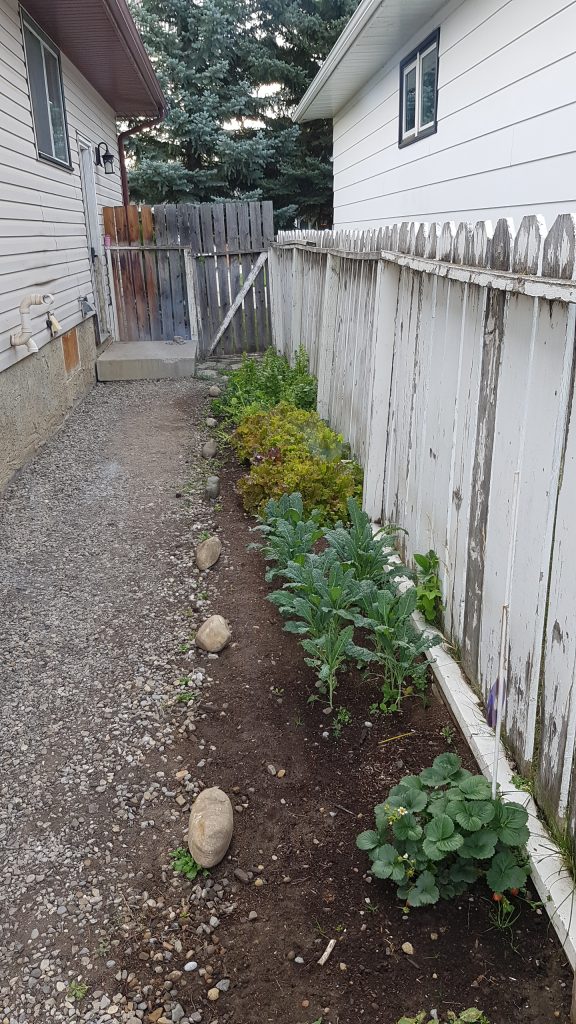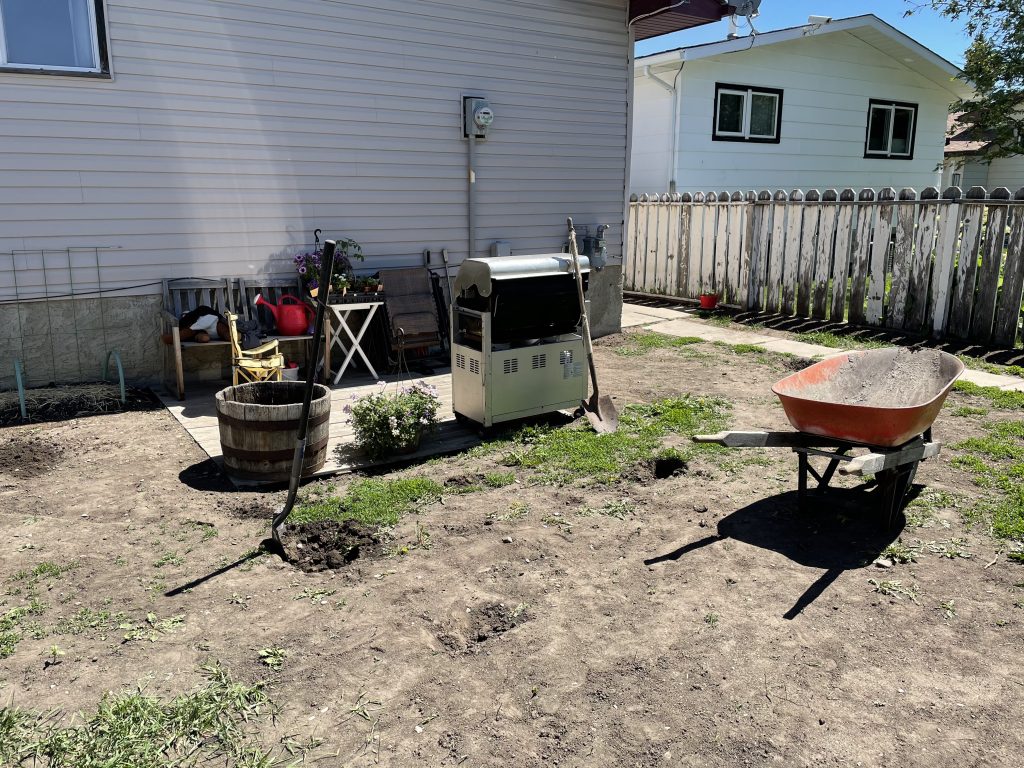
Our Urban Homestead Project of our property – In November of 2019 we moved out of our townhouse, and into a 1979 detached bungalow. Not a fixer-upper, but a place with a lot of potential. Room for improvement, we’ll say. Especially the landscape.
The landscaping is, what I refer to as your “developers special”. It is still used today in new communities around Calgary (for some reason). There is a misplaced Blue Spruce in the front, growing into the neighbours Spruce tree. There was another Spruce in the front at one point. (On the “street view” of the place, there are 2 Spruces, and a cherry growing up the front foundation.) 2 Mugo Pines are growing at the foundation of the house. 2 little (dead luckily) Columnar Aspens, my partner pulled out with one hand, root ball and all. And a Juniper, at the corner of the house. There were also, 3 Cotoneaster root balls by the foundation of the house. 1 on the south side, and 2 on the west side. The neighbour to the South has the Mountain Ash and to the North, the Cherry tree that completes the “special”.
The Juniper is the only thing that is staying in the long run. The garden in the top picture is the vegetable garden we installed in replacement of the Cotoneasters, which replaced the Spruce tree at some point. See the bare spot in the pic below. That used to be a Spruce tree.

Our Urban Homestead Project – An Organic Urban Homestead
Basically, what I am going for, is an urban homestead. It has the home & office already. Big garage and shop area also. I plan to turn the front yard into a food producing garden area. The park pad in the back will be a 4-season green house. I have a spot in mind for a chicken coop, and the back will be lined with gardens equipped with cold frames. The whole thing will be plumbed into the down spouts from the buildings. To fully utilize what little rain we get here. And, it will all be self-sufficient. Mostly….other than annual vegetable plantings.
The Budget.

There isn’t one. Or, rather the budget is 0$.
My whole premise with this makeover is that is does not need to cost a fortune to do this. One of the biggest guidelines with organic / regenerative / ecological land care is using what is available locally. Repurposing things, and allowing the natural processes to take place. These are the things that will keep the costs low.
Below is the description of year one.
The trade off for keeping the cost low, is that it will take more time to complete. With any luck, I have the time. It’s mainly a 3 year plan.
I’ll break it down more in the description below, but the total cost for year 1 totaled about $325.00.
If you would like to see more of the process, click on one of the galleries below.
Front Garden
Back Garden
South Side Pathway Garden
Experience
I have been working with the landscape, soil, and food most of my life, in various disciplines. Gardener to line cook to environmental soil consultant, and everything in between. I will draw on most of these learned skills throughout this process and I will add links to this page as we go to share what I can.
As always, following the teachings and guidelines from Gaia College and the Canadian Society for Organic Urban Land Care.
Our Urban Homestead Project – An Organic Urban Land Care Redesign
Before & … During
Lets Get Started
The back yard had been home to a few dogs in the past. They were allowed to own the place. The grass left when we moved in, was hurting. Mostly exposed, compacted soil. Covered with the remanence of the dogs, and cats.

There are 2 holes on the left in the above picture. Next to the metal window well. The 2 Cotoneaster root balls we removed. The straw in the foreground is buried Bokashi Compost I brought with us.
Get Something In The Ground For Year 1
The Spring is a busy time of year. There is a short growing season in southern Alberta. We need to get things planted. We moved in November, so I wanted to take the year to study the sun. So most things we planted early in the year were annuals. Mainly vegetable seeds. To get them started. I tried to guess based on the sun being to the south, where things would do the best. The worst case would be just to not plant that plant there again next year.

But first, to make garden spaces. We took up the row of bricks on the left in the picture above, and on the right below, for a shaded garden along the fence.
What I am doing is moving things around that are here, just in the wrong place. Let’s see what we have before we import anything.

This is what it looked like most of the summer. There was more lettuce and spinach than we could eat. The kids even set up a lettuce stand in the front. They sold a few pounds, and even fooled a couple of people. They thought the sign said Lemonade. That was funny.


The raised wicking beds are installed, and plumbed together. In the spring there will be cold frames added. There will be a page about these particular beds in the future.
There was a little garden along the garage.
It was mainly a cat bathroom. Side note, the cat keeps coming back. Or at least there is a cat still comes to that area of the garden. I have put forks in the ground as a deterrent. The expanded garden get a lot of morning sun all year long. There will be cold frames there at some point. The compost pile in the bricks, has moved around a couple of times this summer. It now lives where the pallets are below.

The gravel patch in the foreground is just a patch of property to pour, or put, things that may kill the grass. Hot water, old vinegar, bad coffee, that sort of thing. You can see the quality of the grass.
Come August, the Spaghetti Squash has taken over. All the lattice work I had, and the burlap. The side of an old day bed I tore out of an overgrown Sea Buckthorn in July. The Squash doesn’t care what it grows up tied to, but I have plans next year to cover this wall in lattice as I find it.



We planted Glass Gem Corn and Cherry Quinoa along the fence. We didn’t get any Quinoa, though that may have been my fault. The Sunflowers planted by the birds over the Winter. Now that I know how many will come up, I won’t let so many sprout next year.
Our Urban Homestead Project – A New Wooden Backyard Deck
There was a “floating” 10’x10′ deck in the back yard. We will use this as a deck until we build the new one.
After removing the concrete walkway, there was a layer of gravel and sand to remove. To be done before the garden is installed by the fence. The front garden started it’s life as a rock mulch filled monstrosity as well. The whole front garden had 8″ of gravel in it. We removed all of that and made a gravel base for the deck. We removed the top soil from the area first and put down the gravel.

You can see the cut out for the gardens along the house and fence. I am not concerned at this point about edges of gardens. They will alter in accordance to this years performance. Get the garden space “in” enough for vegetable seeds to sprout. Worry about the rest in the fall.

The new window well and adjacent gardens are more finished in this picture too. We are leaving the Corn and Sunflower stalks and remaining flowers up for the birds. As the weather takes them down they will become winter ground cover for the new garden soil.

This is how we left it for the winter. We will wait until the spring to build the new, elevated, deck. Digging out what will be underneath, I am giving us some more storage area, and giving the kids an area to go in the shade. Also, I used the topsoil to level the lawn area.
Our Urban Homestead Project – The Front Garden

The garden in front of the house, where the Mugos were, will be mainly a pollinator garden, though the blueberries are there.
The front garden redesign is to turn the traditionally landscaped, and unused, front lawn into a food producing, beautiful, garden. Even the grasses will be edible. The front step will be another wooden deck. Leading to a ground level patio (of some description).

The gardens have been installed using the “Lasagna Garden” or “Sheet Mulching” technique. I am documenting this part of the transformation on the “Grow Your Own Food” page.
